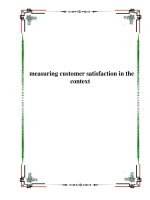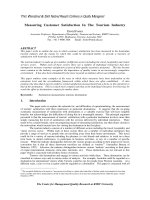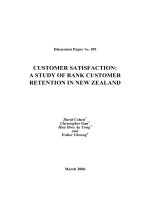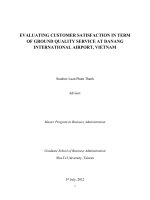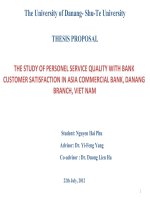EVALUATING CUSTOMER SATISFACTION IN TERM OF GROUND QUALITY SERVICE AT DANANG INTERNATIONAL AIRPORT, VIETNAM
Bạn đang xem bản rút gọn của tài liệu. Xem và tải ngay bản đầy đủ của tài liệu tại đây (177.2 KB, 9 trang )
EVALUATING CUSTOMER SATISFACTION IN TERM
OF GROUND QUALITY SERVICE AT DANANG
INTERNATIONAL AIRPORT, VIETNAM
Student: Luan Pham Thanh
Advisor:
Master Program in Business Administration
Graduate School of Business Administration
Shu-Te University, Taiwan
5
th
July, 2012
1
1. TITLE
Evaluating Customer Satisfaction in term of ground quality service at Danang International
Airport, Vietnam.
2. BACKGROUND
2.1 Customer Satisfaction Studies In The World
In recent years, customer satisfaction has garnered much attention, especially in marketing,
planning and management. The main motivation is that customer satisfaction often leads
to customer loyalty and, consequently, a more advantaged position in the market with high
profitability (13). According to Tu¨rkyılmaz, satisfied customers return, buy more and are
more willing to share their experiences to others (14). In many cases, customer satisfaction is
not only a powerful concept to measure performance within an organization, it also provides a
focus for employees to work toward. For instance, an employee who provides extra services and
attention is considered a more desired employee because he or she is making customer happier
and, thus, increase the livelihood of attaining or retaining that customer’s future business.
Customer satisfaction has become such an important concept that the extent to how much an
organization fulfills its role of increasing its customers’ satisfaction is a strong indication of that
organization’s future income and prospect.
While no one disputes the importance of this concept, there are limited researches to quantify
the state of “being satisfied.” The main obstacle is that satisfaction is a feeling, and the state of
satisfaction is related to both psychological and physical state and varied greatly from person
to person. In many cases, a state of being ‘satisfied’ changes readily after a slight change in the
environment. Theoretically, satisfaction is “defined as a customer’ post-purchase evaluation of a
product or service”
Models used to examine customer satisfaction are many. Most prominently used are
disconfirmation model, perceived value and .
Customer satisfaction has taken into a more prominent role in national and international stage
with the introduction of national customer satisfaction indices (CSI). With these new national
CSIs, the idea of cross-industry and cross-nation index is welcomed by researchers as a
desired new approach. Among these CSIs, some of the most prominent are Swedish Customer
Satisfaction Barometer (SCSB), the American Customer Satisfaction Index (ACSI) and
Norwegian Customer Satisfaction Barometer (NCSB) (15). Other similar CSIs are pilot tested
in New Zealand, Austria, Korea, and the European Union (15). SCSB was the first national
SCI, established in 1989 (14). It was applied to 130 companies in 32 Swedish industries. The
ACSI was developed based on the SCSB in1993 by the Claes Fornell, a founder of SCSB. The
ACSI survey was used in 7 main industry sectors, 35 industries, and more than 200 companies.
The ECSI was first introduced in 1999 across 11 European countries. Amid the proliferation of
2
national SCIs, it still remains to be seen whether one of these national CSIs would eventually rise
to become an international standard and be adopted by a wide range of nations.
According to Johnson, Anderson, and Fornell (1995) (15), customer satisfaction researches have
been developed around 2 primary principals: transaction-specific satisfaction and cumulative
satisfaction. The original researches focus on customer satisfaction within one encounter of
a product or service. In another words, each encounter is treated separated and has no further
impact to the next evaluation of customer satisfaction. This approach put more emphasis on “the
relationship between perceived quality and satisfaction and the role of emotion in satisfaction
evaluation” (15). Recently, more interests are put on cumulative satisfaction approach.
Cumulative satisfaction is a customer’s overall experience to date with a product or certain
provider (15). The advantage of this new approach is that it is better at predicting subsequent
behavior and economic performance (14) because customers make their purchase decisions
based mostly on their experience to date, not from a particular encounter or transaction (15).
CSI model is defined as “a structural model based on the assumption that customer satisfaction is
caused by some factors such as perceived quality, perceived value, and expectation of customers
and the image of the firm” (14).
2.2 Vietnam Air Transport Overview
Originally founded as a military force according to Decision No. 666/TTG of the Vietnamese
government in January 1956 (12), The Civil Aviation Administration of Vietnam (CAAV)’s
main objective was “state management, national defense, and the commercialization of air
transportation”(12). During its early years, the agency greatly expanded the number airplanes
from a few aircraft to a fleet of 50 aircraft after the unification of Vietnam in 1975(12). After
1975, a reform was mounted to address the inefficiency problem within the agency and refocus
the agency’s objectives away from military purposes to civilian services of “air transportation
and air service” (12). In 1990s, known as the Reformation Period, Vietnam Airlines was
established. This new airline is a national flagship carrier and enjoys a healthy growth of
revenue, especially after the president Bill Clinton lifted the trade embargo in 1994. Its revenue
in 2008 is $1.56 billion and $1.3 billion in 2009.
According to (11), the future for Vietnamese Aviation is bright but cannot be taken for granted.
By 2014, “Vietnam would be the world third fastest growing market for international passengers
and freight, and the second fastest for domestic passengers” (11). Vietnam has 22 airports
throughout its border, of which 9 are international airports. The major airports are Noi Bai
International Airport in the North, Tan Son Nhat International Airport of the South and Danang
Airport in the Central.
2.2 Introduction To Danang City, Vietnam
3
Danang is one of three major cities in central Vietnam. The city is located at the coast and half
way between the two other major cities, the political and administrative capital of Hanoi in the
North and the commercial center of Ho Chi Minh City in the South (8). Well sheltered, easily
accessible by sea, train and air, Danang is a hub of transportation and a center of commerce
and education of central Vietnam. After 1997, Danang is separated from Quang Nam province
to become a centrally-controlled independent municipality. Boasting a GDP growth of 11%
annually (Danang People Committee 5), Danang has a prospect of a healthy and growing
economy with a strong focus on tourism and manufacturing industry.
Tourism has a strong connection with air transport since most tourists are more likely to fly to
their intended destinations than to use other means of transport. In Danang, tourism is becoming
an increasingly vital part of Danang economy. In recent years, the number of tourists coming
to Danang has significantly increased, reaching 1.77 million tourists in 2010 including 370,000
international visitors (7). The industry generated total revenue of $43 million and accounted for
4,200 wage earners and entrepreneurs in 2007 (8). Bestowed with natural beauties and Danang’s
proximity to many UNESCO Heritage sites, including the Imperial City of Hue, the old town
of Hoian and the My Son ruin, Danang’s natural inclination to tourism is strongly supported
by the local government. One obvious example is that the local government “helped resort
developers quickly clear land and provided infrastructure needed for [many world-class resort
destinations],” (9) such as Crown Plaza, The Hyatt Regency, Mercure, Novetel, etc. The opening
of the new Danang international airport further contributed to the increase of tourists coming to
the city. Since the new terminal opened its doors at the end of 2011, the number of visitors in
the first quarter of 2012 rose 31.9 percent compared to the same quarter last year. For a tourist
centric city like Danang, a seamless transportation system is critical because it serves as an
important tool to promote tourism of the city, attract new customers and transport a high volume
of passengers.
Industry is another major contributor to Danang economy. Issue
2.3 Introduction To Danang International Airport
Danang International Airport is located in Danang, the largest city in central Vietnam. It is also
the third largest and busiest airport in Vietnam, beside Noi Bai International airport in Hanoi and
Tan Son Nhat in Ho Chi Minh City. In 2006 the airport saw its passengers pass 1 million for the
first time since 1975 and projected to welcome around 4 million passengers by 2020 (10). To
cope with an increase in passengers and future demands, a new terminal is put into operation at
the end of 2011. The Danang airport has a monopoly over the market, meaning that there isn’t
another airport in the region to compete against. However, satisfaction of customers is still very
important. Depending on satisfaction level, it has the direct impact on the likelihood of a traveler
coming back to Danang, or his willingness to recommend to another traveler about visiting
Danang. In addition to prospect of future income, a positive perception is crucial to a city such
as Danang whose effort has been put forth to cultivate an image of a tourist-friendly city. Air
4
transport is related to tourism because “very few people fly for the sake of flying, as the great
majority flies to go somewhere and do something.” Given the strong interconnection between air
transport and Danang’s goal to become a major tourism destination, it is suitable for the city to
invest in customer satisfaction.
The airport has direct flight to Singapore, Thailand, Taiwan, etc. and have an average of 24
flights per day.
Customer satisfaction is a key concept to measure performance within an organization. It focuses
in whether a service meet or surpasses customers’ expectation. Using this concept correctly can
yield This concept is an important factor for enterprises to determine
2.5 Customer Satisfaction in Danang International Airport
No data L. Maybe that’s why I’m doing this.
3. RESEARCH QUESTION
4. THEORETICAL FRAMEWORK
4.1 The Original Swedish Customer Satisfaction Barometer (SCSB)
The SCSB is first established in 1989 to measure purchased and consumed products and services
(15). Since then, its successors have evolved into many other national CSIs. The most notable is
the ACSI; other national CSIs have been adopted in smaller scale in New Zealand and Taiwan
(15), and SCSB is still the basic model being used in Norway and the European Union.
According to (15), the original SCSB contains 2 primary antecedents of satisfaction: Perceived
Performance (Value) of a customer when receive a service or product and Customer Expectation
prior to receiving the service or product. The Perceived Performance is the customer’s perception
of the quality received from the service or product in comparison with the price paid. The basic
prediction here is that when the perceived performance increases, customer satisfaction also
increases. The remaining antecedent is Customer Expectation. Customer Expectation is defined
as what the customers “predict” rather than a formal benchmark. These expectations are argued
to serve as a psychological anchor. It captures customers’ past experience as well as word-of-
mouth comment and advertisements from various sources to form customers’ opinion on the
product or service. As with Perceived Performance, Customer Expectation is argued to have
a positive effect on Customer Satisfaction, i.e. the higher the expectation the higher customer
satisfaction.
5
Figure 1. The SCSB (Swedish Customer Satisfaction Barometer) model
4.2 The American Customer Satisfaction Index (ACSI)
The ACSI is established in 1994 by researchers the University of Michigan and build upon the
SCSB model and the theory of Hirschman ()’s Voice-exit . This model was modified to be more
suitable for the American economy. The main difference of ASCI to the previous SCSB model
is a new Perceived Value variable, distinct from Perceived Performance of SCSB. In 1996, the
ACSI model was expanded to distinctly include 2 types of perceived quality: physical product
quality and service quality (15). Following this expansion, the questionnaires given to customer
include questions for both the product and service aspect separately. It is particular useful for
industries that service both products and customer service, i.e. computer store selling both
physical products and service.
6
Perceived
Performance
(Value)
Customer
Expectation
Customer
Satisfaction
(SCSB)
Figure 2. The ACSI (American Customer Satisfaction Index) model
5. RESEARCH METHODOLOGY
This research aims to provide a first look into customer satisfaction aspect at Danang
International Airport. As researches of this kind have never been conducted at Danang
International Airport, the main goal is exploratory and test piloted for future researchers. To this
aim, we will be using Q2 construct and
6. SIGNIFICANCE OF THE RESEARCH
The new Danang International Airport was recently put into operation. Therefore, data of
customer satisfaction and performance in this new airport is limited. This research aims to
provide information on the following topics:
•
Evaluate the current status of Customer Satisfaction at the airport.
•
Suggest projects that are small in scope and financial support but have the maximum
impact to improve the enjoyment of visiting passengers and airline companies.
•
Estimate the impact from increase in number of passengers to the airport’s operational
capacity and passengers’ satisfaction in the near future.
•
Increase the quality and quantity of communication channels to get feedback from
passengers and airliners.
7
Customer
Expectations
Perceived
Quality
Perceived
Value
Customer
Satisfaction
(ASCI)
7. REFERENCE LIST
1/ />ad2/ />overview_of_da_nang_city?expandable=0h
3/ />eCm4XYC&oi=fnd&pg=PA197&dq=oligopoly+customer+satisfaction+airport&ots=oLhNqLyR58&
sig=zE51u8WAbthMwnIcJ6MKFgO_cv8&redir_esc=y#v=onepage&q&f=false
4/
Air Transport in the 21st Century: Key Strategic Developments
By John F. O'Connell, George Williams
5/
/>CateId=News_Investment_Enviroment&NewsId=168 Danang People Committee
6/
7/
/>8/
Final report on Parcipatory Tourism Value chain Analysis In Danang, Vietnam
9/
/>10/
/>11/
/>8
12/
/>13/ Measuring the efficiency of customer satisfaction and loyalty for mobile phone brands with
DEA
14/ Development of a customer satisfaction index model An application to the Turkish mobile
phone sector
15/ The evolution and future of national satisfaction index models
8. TIMETABLE
9

